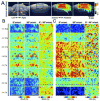Spatiotemporal characteristics and vascular sources of neural-specific and -nonspecific fMRI signals at submillimeter columnar resolution
- PMID: 22960251
- PMCID: PMC3508161
- DOI: 10.1016/j.neuroimage.2012.08.064
Spatiotemporal characteristics and vascular sources of neural-specific and -nonspecific fMRI signals at submillimeter columnar resolution
Abstract
The neural specificity of hemodynamic-based functional magnetic resonance imaging (fMRI) signals is dependent on both the vascular regulation and the sensitivity of the applied fMRI technique to different types and sizes of blood vessels. In order to examine the specificity of MRI-detectable hemodynamic responses, submillimeter blood oxygenation level-dependent (BOLD) and cerebral blood volume (CBV) fMRI studies were performed in a well-established cat orientation column model at 9.4 T. Neural-nonspecific and -specific signals were separated by comparing the fMRI responses of orthogonal orientation stimuli. The BOLD response was dominantly neural-nonspecific, mostly originating from pial and intracortical emerging veins, and thus was highly correlated with baseline blood volume. Uneven baseline CBV may displace or distort small functional domains in high-resolution BOLD maps. The CBV response in the parenchyma exhibited dual spatiotemporal characteristics, a fast and early neural-nonspecific response (with 4.3-s time constant) and a slightly slower and delayed neural-specific response (with 9.4-s time constant). The nonspecific CBV signal originates from early-responding arteries and arterioles, while the specific CBV response, which is not correlated with baseline blood volume, arises from late-responding microvessels including small pre-capillary arterioles and capillaries. Our data indicate that although the neural specificity of CBV fMRI signals is dependent on stimulation duration, high-resolution functional maps can be obtained from steady-state CBV studies.
Copyright © 2012 Elsevier Inc. All rights reserved.
Figures







Similar articles
-
Cortical layer-dependent dynamic blood oxygenation, cerebral blood flow and cerebral blood volume responses during visual stimulation.Neuroimage. 2008 Oct 15;43(1):1-9. doi: 10.1016/j.neuroimage.2008.06.029. Epub 2008 Jul 4. Neuroimage. 2008. PMID: 18655837 Free PMC article.
-
Neural interpretation of blood oxygenation level-dependent fMRI maps at submillimeter columnar resolution.J Neurosci. 2007 Jun 27;27(26):6892-902. doi: 10.1523/JNEUROSCI.0445-07.2007. J Neurosci. 2007. PMID: 17596437 Free PMC article.
-
Mapping iso-orientation columns by contrast agent-enhanced functional magnetic resonance imaging: reproducibility, specificity, and evaluation by optical imaging of intrinsic signal.J Neurosci. 2006 Nov 15;26(46):11821-32. doi: 10.1523/JNEUROSCI.3098-06.2006. J Neurosci. 2006. PMID: 17108155 Free PMC article.
-
Linking brain vascular physiology to hemodynamic response in ultra-high field MRI.Neuroimage. 2018 Mar;168:279-295. doi: 10.1016/j.neuroimage.2017.02.063. Epub 2017 Feb 22. Neuroimage. 2018. PMID: 28254456 Review.
-
Non-BOLD contrast for laminar fMRI in humans: CBF, CBV, and CMRO2.Neuroimage. 2019 Aug 15;197:742-760. doi: 10.1016/j.neuroimage.2017.07.041. Epub 2017 Jul 20. Neuroimage. 2019. PMID: 28736310 Review.
Cited by
-
Uses, misuses, new uses and fundamental limitations of magnetic resonance imaging in cognitive science.Philos Trans R Soc Lond B Biol Sci. 2016 Oct 5;371(1705):20150349. doi: 10.1098/rstb.2015.0349. Philos Trans R Soc Lond B Biol Sci. 2016. PMID: 27574303 Free PMC article. Review.
-
Sensory and optogenetically driven single-vessel fMRI.Nat Methods. 2016 Apr;13(4):337-40. doi: 10.1038/nmeth.3765. Epub 2016 Feb 8. Nat Methods. 2016. PMID: 26855362 Free PMC article.
-
Ultra-Slow Single-Vessel BOLD and CBV-Based fMRI Spatiotemporal Dynamics and Their Correlation with Neuronal Intracellular Calcium Signals.Neuron. 2018 Feb 21;97(4):925-939.e5. doi: 10.1016/j.neuron.2018.01.025. Neuron. 2018. PMID: 29398359 Free PMC article.
-
Mechanical restriction of intracortical vessel dilation by brain tissue sculpts the hemodynamic response.Neuroimage. 2015 Jul 15;115:162-76. doi: 10.1016/j.neuroimage.2015.04.054. Epub 2015 May 5. Neuroimage. 2015. PMID: 25953632 Free PMC article.
-
High spatiotemporal vessel-specific hemodynamic mapping with multi-echo single-vessel fMRI.J Cereb Blood Flow Metab. 2020 Oct;40(10):2098-2114. doi: 10.1177/0271678X19886240. Epub 2019 Nov 7. J Cereb Blood Flow Metab. 2020. PMID: 31696765 Free PMC article.
References
-
- Berwick J, Johnston D, Jones M, Martindale J, Martin C, Kennerley AJ, Redgrave P, Mayhew JEW. Fine Detail of Neurovascular Coupling Revealed by Spatiotemporal Analysis of the Hemodynamic Response to Single Whisker Stimulation in Rat Barrel Cortex. Journal of Neurophysiology. 2008;99:787–798. - PMC - PubMed
-
- Chen LM, Turner GH, Friedman RM, Zhang N, Gore JC, Roe AW, Avison MJ. High-resolution maps of real and illusory tactile activation in primary somatosensory cortex in individual monkeys with functional magnetic resonance imaging and optical imaging. The Journal of Neuroscience. 2007;27:9181–9191. - PMC - PubMed
Publication types
MeSH terms
Grants and funding
LinkOut - more resources
Full Text Sources
Other Literature Sources
Medical
Miscellaneous

